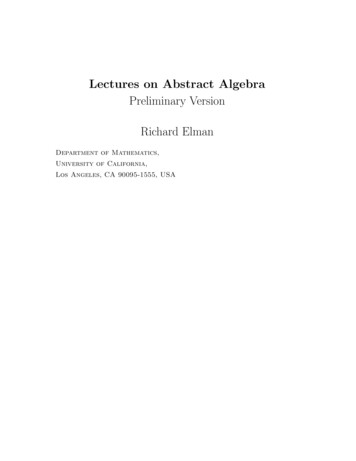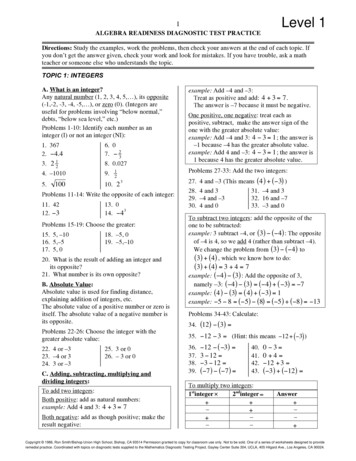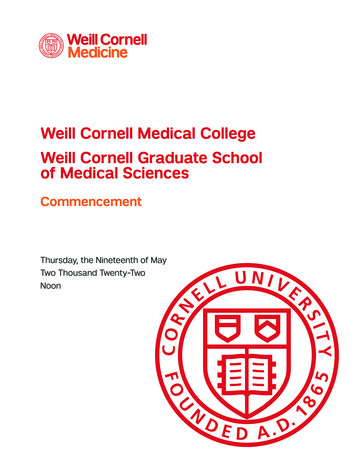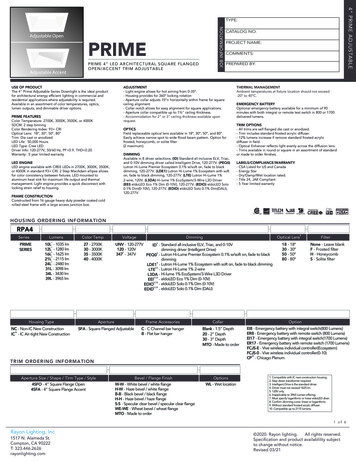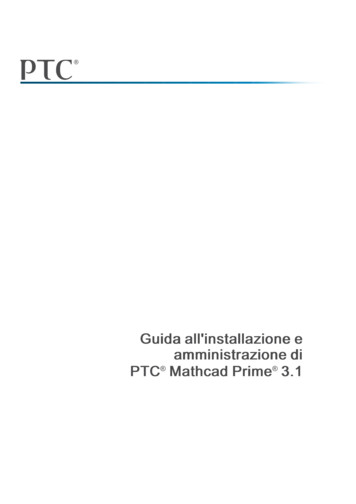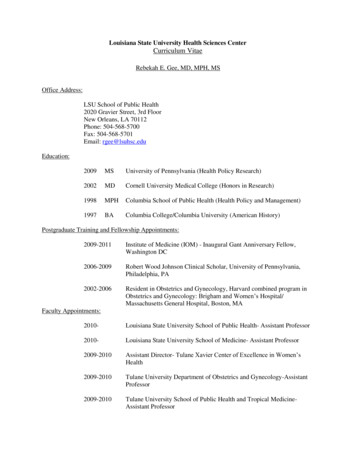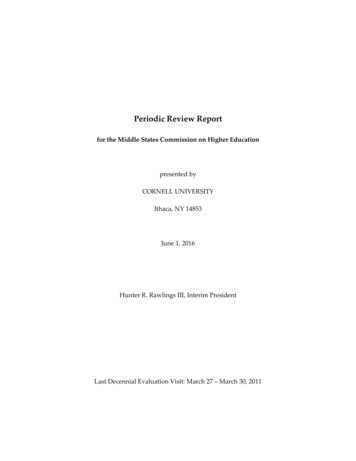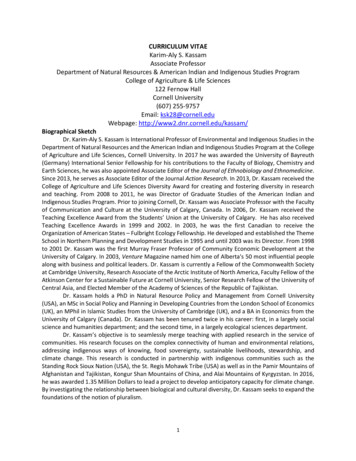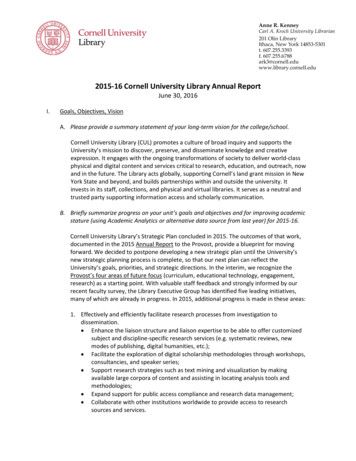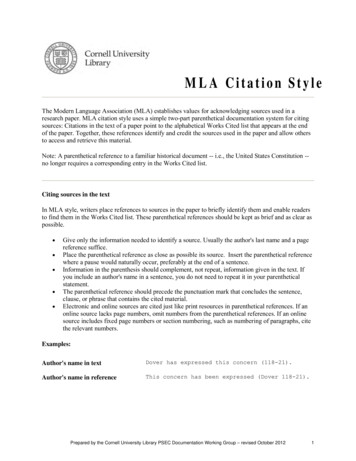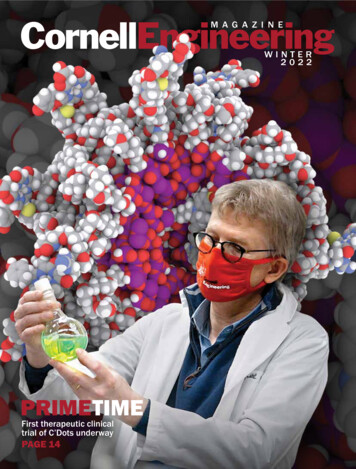
Transcription
M A G A Z I N EWINTER2022PRIME TIMEFirst therapeutic clinicaltrial of C’Dots underwayPAGE 14
MESSAGEFROM THEDEANLYNDEN A. ARCHEROur world is more connected now than at any time inhistory. Technology, ideas, information and culturesare colliding in new ways and at an unprecedentedscale and complexity.How do we educate students who are able to thrive inthis environment? What investments are needed to innovateimpactful solutions to the most difficult problems of our time,such as those relating to climate and energy systems, precisionmedicine and human health, and inequitable access to STEMeducation? How do we go about un-siloing engineeringdisciplines to catalyze convergent approaches that transcenddisciplinary boundaries and contribute to positive change?There is more at stake now in finding actionable answers tothese questions than ever before.Cornell Engineering is uniquely positioned to develop andimplement meaningful solutions that make a sustained impact.Our 150-year-old college’s well-earned reputation for rigor andexcellence in teaching and research, Cornell’s deeply ingrainedculture of collaborating across disciplines, and our demonstratedcommitment to diversity and inclusion provide pillars uponwhich we’ll build new paradigms for engineering education,research, and technology translation.This is our time!To seize the moment, we’ve developed a strategic plantermed Cornell Engineering 2030. I invite you to read moreabout it on our website.The plan specifically calls for focused investments inpeople, programs, and infrastructure that will position CornellEngineering for national and international leadership.In education, we will invest in faculty and staff committedto innovating in the classroom to enhance learning. We willintegrate leadership, ethics, and professional developmenteducation throughout our undergraduate and professionalmaster’s degree programs. We will develop distance learningoptions that improve flexibility for traditional residentialstudents, as well as to increase the college’s reach to nontraditional students where they work and live.In research, we will create mechanisms for rewarding,promoting, and celebrating excellence. To un-silo engineering,we will prioritize recruitment of faculty leaders whose scholarlywork lies at the intersection of traditional disciplinary domainsin the college. We will also invest in One Cornell Engineeringinitiatives that build new bridges to Cornell Tech and WeillCornell Medicine. Finally, we will modernize the college’s aginginfrastructure — building by building — to create state-of-the artfacilities that support new exploration in old and new domainsof scholarship.Our goals are ambitious, and I look forward to keeping youupdated as we approach them.CornellEngineeringTABLE OFWINTER 2022CORNELLENGINEERINGMAGAZINEVolume 24, Number 2Winter 2022Cornell EngineeringMagazine is publishedby the Cornell UniversityCollege of EngineeringFEATURESMAGAZINEPush print: Pioneering the 3D-printingtechniques of tomorrowJoseph Silbert Deanof EngineeringLynden ArcherExecutive EditorReeve HamiltonEditorsBy Jackie Swift.10Syl KacapyrChris DawsonGraphic DesignRobert KurcobaPrime time: First therapeutic clinical trial of C’DotsunderwayPrinterCornell Print ShopBy Tom Fleischman.14Meet the human teaching machines about trustBy Eric Laine.20Q&A with Mohamed Ali, Ph.D. ‘97, GE Aviation.24PhotographyAll photos by UniversityPhotography,Robyn Wishna, unlessotherwise indicated.Editorial andBusiness Offices252 Carpenter HallIthaca, NY 14853-2201phone 607 255-6095fax 607 255-9606e-mail cornell engr mag@cornell.eduVisit Cornell EngineeringMagazine online atwww.engineering.cornell.edu/magazine 2022Cornell Engineering MagazinePrinted on recycled paper.14102024DEPARTMENTSNEWSLynden A. ArcherJoseph Silbert Dean of EngineeringJames A. Friend Family DistinguishedProfessor of Engineering2NANOSTORIES8AWARDS22CORNELL ENGINEERING 1
NEWSCornell Engineering NewsThis image shows an electron ptychographic reconstruction of a praseodymium orthoscandate (PrScO3) crystal,zoomed in 100 million times.CORNELL RESEARCHERS SEE ATOMSAT RECORD RESOLUTIONIn 2018, Cornell researchersbuilt a high-powereddetector that, in combinationwith an algorithm-drivenprocess called ptychography,set a world record by triplingthe resolution of a state-of-theart electron microscope.As successful as it was, thatapproach had a weakness. Itonly worked with ultrathinsamples that were a few atomsthick. Anything thicker wouldcause the electrons to scatterin ways that could not bedisentangled.Now a team, again led byDavid Muller, the SamuelB. Eckert Professor ofEngineering, has bested itsown record by a factor of twowith an electron microscopepixel array detector (EMPAD)that incorporates even moresophisticated 3D reconstructionalgorithms.The resolution is so finetuned, the only blurring thatremains is the thermal jigglingof the atoms themselves.“This doesn’t just set a newrecord,” Muller said. “It’sreached a regime which iseffectively going to be anultimate limit for resolution.We basically can now figureout where the atoms are in avery easy way. This opens up awhole lot of new measurementpossibilities of things we’vewanted to do for a very longtime. It also solves a longstanding problem – undoingthe multiple scattering of thebeam in the sample, whichHans Bethe laid out in 1928 –that has blocked us from doingthis in the past.”Ptychography worksby scanning overlappingscattering patterns from amaterial sample and lookingfor changes in the overlappingregion.“We’re chasing specklepatterns that look a lot likethose laser-pointer patternsthat cats are equally fascinatedby,” Muller said. “By seeinghow the pattern changes, weare able to compute the shapeof the object that caused thepattern.”The detector is slightlydefocused, blurring the beam,in order to capture the widestrange of data possible. Thisdata is then reconstructed viacomplex algorithms, resultingin an ultraprecise image withpicometer (one-trillionth of ameter) precision.This latest form ofelectron ptychography willenable scientists to locateindividual atoms in all threedimensions when they mightbe otherwise hidden usingother imaging methods.Researchers will also beable to find impurity atomsin unusual configurationsand image them and theirvibrations, one at a time. Thiscould be particularly helpfulin imaging semiconductors,catalysts and quantummaterials – including thoseused in quantum computing –as well as for analyzing atomsat the boundaries wherematerials are joined together.The imaging method couldalso be applied to thickbiological cells or tissues, oreven the synapse connectionsin the brain.HOVER JOINS SURFSIDE COLLAPSEINVESTIGATION TEAMConcrete expert Ken Hover,Ph.D. ’84, professor inthe School of Civil andEnvironmental Engineering,will play a key role on anexpert team assembled bythe federal governmentto investigate the June 24,2021, partial collapse of theChamplain Towers Southcondominium in Surfside,Florida.The U.S. Department ofCommerce’s National Instituteof Standards and Technology(NIST) announced thecomposition of the team, which2 WINTER 2022aims to determine the technicalcause of the collapse and,if indicated, to recommendchanges to building codes,standards and practices, orother appropriate actions toimprove the structural safety ofbuildings.Hover will co-lead theinvestigation’s materialsscience project, which willwork to evaluate the strength,appropriateness, uniformityand deterioration of materialsused in specific buildingfeatures and at differentfloors in the building. Thesefindings will be compared withthe characteristics specifiedin the building design, andthe data will be used in thepartial collapse analyses andsimulation.“One of the things that makesme a good fit for this teamis my extended professionaldesign and constructionexperience, in addition tomy years of teaching andresearch,” Hover said. “I thinkI can play a valuable role here.”Hover said he feels honoredto be part of the newly formedNIST investigation team and isready to do whatever he can todetermine what factors playedMembers of the CROPPS team are pictured on campus. From left: Shannon Spencer, CROPPS program and operations manager; Joyce Van Eck,associate professor at the Boyce Thompson Institute; Abe Stroock, the Gordon L. Dibble ’50 Professor in the Robert F. Smith School of Chemical andBiomolecular Engineering; José Martínez, the Lee Teng-hui Professor of Engineering in Electrical and Computer Engineering, and senior associatedean for diversity and academic affairs; Susan McCouch, Ph.D. ’90, the Barbara McClintock Professor in the College of Agriculture and Life Sciences;and Bruce Lewenstein, professor of communication, CALS. 25M CENTER WILL USE DIGITAL TOOLS TO‘COMMUNICATE’ WITH PLANTSAKen Hover, professor in the Schoolof Civil and EnvironmentalEngineering.a role in the collapse, identifycurrent safety issues and makerecommendations to helpavoid future failures.new multi-institution,transdisciplinary centerwill develop systemsfor two-way communicationwith plants, allowing scientiststo remotely sense a plant’sbiology and its immediateecosystem, in hopes of oneday using the information toimprove plant growth.The new Center for Researchon Programmable PlantSystems (CROPPS), fundedby a five-year, 25 millionNational Science Foundationgrant, aims to grow a newfield called digital biology. Itwill be led by researchers fromthe College of Engineering,College of Agriculture and LifeSciences, and the College ofComputing and InformationScience.CROPPS will developtechnologies connected tothe internet and the cloud –creating an Internet of LivingThings – to listen to and learnhow plants sense and respondto their environments. Asthese tools develop, they willbe made more interactive.The ultimate goal is twoway communication, wherescientists receive informationand respond to what a plantneeds, or to work with theplant’s genetics to affectphysical outcomes.“At the heart of this projectare plants endowed with newways of expressing biologicalprocesses – including hiddenprocesses that occur insidetissues or underground –through a readable signal thatwe can develop technologiesto capture,” said AbrahamStroock ’95, CROPPS codirector and the Gordon L.Dibble ’50 Professor in theSmith School of Chemical andBiomolecular Engineering.At first, the center will worktoward developing digitalplant sensing tools connectedto the cloud and the internet.Some early examples includework by Stroock to developnanoscale sensors and fiberoptics to measure water statusjust inside a leaf’s surface,where water in plants is mostactively managed. Such a toolwould be minimally invasiveand will not only advanceunderstanding of basic plantbiology, but offer informationfor breeding more droughtresistant crops.José Martínez, the Lee Tenghui Professor in the Schoolof Electrical and ComputerEngineering, is a principalinvestigator and HakimWeatherspoon, associateprofessor of computer science,will serve as an associatedirector of the center.CORNELL ENGINEERING 3
Cornell Engineering NewsCORNELL SCIENTISTS TO JOIN TEAMFOR LIVE VOLCANIC ERUPTIONThe newly erupted Cumbre Vieja volcano on La Palma in the Canary Islands illuminates the night sky in earlyOctober.Geographic differences in the microbiome lead to differences in susceptibility to C. rodentium infection in humanized mice. Representative images ofH&E-stained colon sections of control and infected mice 14 days after infection. The arrows depict average crypt length with hyperplasia observed inthe US and FIJI mice. Scale bar represents 100 μm. Control top, infected bottom. Left to right: US, Fiji, Guatemala.GEOGRAPHIC DIFFERENCES IN GUT MICROBIOTABOOST IMMUNITYThe gut microbiome is adiverse environment, jampacked with up to 1,000different species of bacteria.Human populations aroundthe globe have significantdifferences in the compositionof their gut microbiomes,which can impact their healthin unique ways that have notbeen completely understood.Complicating matters, gutmicrobiome research haspredominantly focused onhealth subjects important tohigh-income countries like theUnited States and in Europe,leaving out much of theworld’s health problems.A Cornell-led project hassought to fill in some of thesegaps by studying mice thatwere “humanized” withmicrobiota from three globalpopulations – in the U.S., Fijiand Guatemala – and theirresistance to severe intestinalinfection. The researchersfound that microbialdifferences alone can impact4 WINTER 2022immune responses, and quitequickly at that. They alsoobserved that housing themice together so that theyshared microbiota helped micewith low resistance to infectionbecome more resilient.The project, done incollaboration with researchersfrom the Center for Studiesof Sensory Impairment,Aging and Metabolism inGuatemala, grew out of a2018 Cornell workshop onmicrobes and global healthorganized by Ilana Brito,assistant professor and theMong Family SesquicentennialFaculty Fellow in BiomedicalEngineering in the Collegeof Engineering, who led theteam.A range of factors caninfluence disparities in gutmicrobiome composition, fromgenetics and diet to antibioticuse, sanitation infrastructureand exposure to infectiousdiseases. It can be difficult tocontrol for so many variables,so the researchers tookmicrobiome samples fromthe three global populationsand put them in 30 germ-freemice, then exposed themto Citrobacter rodentium, amodel for severe intestinalinfections like E. coli, to seehow they responded.“You get very differentimmune responses of thesemicrobiomes in these differentmice that led them to beeither more or less resilientto infection,” said Brito,who noted that Guatemalamicrobiota proved mostresistant, followed by the U.S.,then Fiji. “The interesting thingwas they are exhibiting thesedifferences in resilience toinfection in a very short time.This isn’t something that’shappening over generations.”The researchers alsoexposed the mice to Listeriamonocytogenes, but did notsee similar responses, whichsuggests the microbiome isaffecting certain attributes ofthe immune system and notothers, Brito said.In a follow-up experiment,the researchers co-housedmice with microbiomes fromthe three global regions andexposed them to C. rodentium.Because mice consume eachother’s stool, microbiota passbetween them, essentiallymimicking the way a human’smicrobiota compositioncan change when theytravel, change their diet orpermanently immigrate. Theresearchers found that lessresilient mice benefited fromthe sharing of microbiota.The ability to transferresistance to infectiondemonstrates the potential ofharnessing the microbiome fortherapeutic treatments.“I think the broader point isthat we should be studyingthe health effects of microbesthat we find outside of ourbackyard,” Brito said. “Howcould we improve people’shealth with microbiomeinterventions throughout theworld, for different types ofhealth problems? It warrants aglobal view.”Among the Cornell faculty,Esteban Gazel arguablyconducts the hottestresearch. But this time thegeochemist should be safefrom magma heat.Gazel, associate professor inthe Department of Earth andAtmospheric Sciences, anddoctoral student Kyle Daytonjoined a small, elite team ofinternational researchers onOct. 21 at the newly eruptedCumbre Vieja volcano onthe island of La Palma in theCanary Islands – off the coastof western Africa.“The opportunity to be nearan active volcanic duringan eruption is rare,” Gazelsaid. “Volcanoes erupt all thetime, but not all volcanoesare accessible. This volcanohas been well monitored,well understood and wehave enough backgrounddata now to validate any newmeasurements.”Dayton and Gazel willcollect on-site micro and nanosamples of the air carriedby the wind to Tenerife,the largest of the CanaryIslands, as well as the islandof La Palma, as part of aNASA-supported project toinvestigate the global effectsof volcanic ash on the Earthsystems in collaboration withdepartment faculty membersNatalie Mahowald, the IrvingPorter Church Professor ofEngineering; and MatthewPritchard, professor of earthand atmospheric sciences.They will also sample crystalscontaining glass inclusionsto determine the volcano’svolatile budgets, includingcarbon dioxide emissions.Gazel calls Cumbre Vieja’sSept. 19 eruption a nonaggressive one. People livingaround the volcano havebeen evacuated, but manyLa Palma buildings andinfrastructure in the lavapath will be destroyed. Thevolcano erupted mildly in1971 and in 1949; Gazel saidthe 2021 eruption shows nosigns of slowing down.Said Gazel: “All of thismatters so that we canunderstand the internaldynamics of a planet and themechanism behind eruptions.Volcanoes act as probes tounderstand the interior of theEarth.”RESEARCHERS RECEIVE 5.4M TO ADVANCEQUANTUM SCIENCECornell researchers andtheir collaborators willcontinue to advancequantum science andtechnology thanks to 5.4million in new funding fromthe U.S. Department of Energy(DOE).The project “HybridQuantum Magnonics forTransduction and Sensing”received 1.8 million of thefunding and is led by GregFuchs, Ph.D. ’07, associateprofessor of applied andengineering physics.The research aims to makeadvances on one of thefundamental challengesof solid-state quantumtechnologies: networkingquantum processors togetherto exchange information.The project will also focus onquantum-enhanced sensing, byusing magnons – the magneticexcitations in ultra-lowdamping materials – to connectsuperconducting circuits toindividual quantum bits. Bycombining desirable propertiesfrom different quantumsystems, the hybrid systemswill create new opportunitiesfor enhanced quantumfunctionality, including thecontrol of large-scale quantumstates, new interconnectsfor solid-state quantum bits,and the ability to controlthe direction of quantuminformation flow.“I’m excited to pushmagnetic materials into thequantum limit to enablenew ways to make quantumdevices,” Fuchs said. “Theproject is fundamental,but the opportunity is totake advantage of the factthat magnetic materials arenonreciprocal, meaningthey can enforce ‘one-way’interactions. That is currentlydifficult in quantum systems.”The Cornell project “PlanarSystem for QuantumInformation” received 3.6million and is led by Jie Shan,professor of applied andengineering physics (CornellEngineering).Shan and collaboratorswill focus on developingmoiré materials for quantumsimulation, which are formedby overlaying layers of 2Dmaterials with a small twistangle or lattice mismatch.Electrons can tunnel betweentraps created by the moiréstructure, presentingunprecedented possibilitiesfor simulation of interactingquantum particles in a solidstate platform.The project will also developadvanced methods for materialsynthesis and 2D assembly,such as bulk crystal growthusing a flux synthesis methodand the creation of tailored2D heterostructures with ondemand control of rotationangle using dry transfertechniques.CORNELL ENGINEERING 5
Cornell Engineering NewsSCIENTISTS HARNESS MACHINE LEARNING TOLOWER SOLAR ENERGY COSTAJohn A. Swanson ’61, M.Eng. ’63, left, speaks with Lynden Archer, the Joseph Silbert Dean of Engineering, in Duffield Hall on Oct. 14.ANSYS FOUNDERSWANSON RECEIVESENGINEERING ALUMNIAWARDWhen John A. Swanson’61, M.Eng. ’63,launched his owncompany, Swanson AnalysisSystems Inc., in 1970, hehoped it would give him theopportunity to work with ahandful of employees whoshared his enthusiasm forsoftware.He did not know it wouldgrow into what is now knownas ANSYS Inc., a global leaderin developing engineeringsimulation and technologiesused by engineers anddesigners across a broadspectrum of industries.“Don’t try to predict life,”Swanson told an in-person and6 WINTER 2022virtual audience from a stagein Duffield Hall on Oct. 14.Swanson, a knowninnovator in the applicationof finite-element methods ofengineering, was honoredwith the 2021 CornellEngineering DistinguishedAlumni Award in recognitionof his extraordinary leadershipand vision, and the distinctionhe has brought to the college.“John’s boundlessenthusiasm for engineeringeducation, and his exceptionalgenerosity with his time,knowledge and resources,have had an enduring impacthere at Cornell and beyond,”said President Martha E.Pollack, who highlighted thebreadth of areas that Swansonand his wife, Janet, havesupported at Cornell andelsewhere.Among the university’sforemost benefactors, theSwansons have givengenerously to the College ofEngineering and the Collegeof Veterinary Medicine, withgifts to programs – includingthe Swanson Laboratory forAdvanced Simulation – aswell as faculty support,scholarships and capitalprojects. He has also servedon multiple advisory councils,including the EngineeringCollege Council.In a lively, in-persondiscussion with LyndenArcher, the Joseph SilbertDean of Engineering, Swansontouched on his small-townupbringing, his success inbusiness, his recent focus onrenewable energy and hislong-standing commitment tophilanthropy.“My opinion is thatengineering is the world’sgreatest career,” Swanson said.Elected to the NationalAcademy of Engineeringin 2009, Swanson receivedhis bachelor’s and master’sdegrees in mechanical andaerospace engineering fromCornell, and his Ph.D. fromthe University of Pittsburgh,where the Swanson Schoolof Engineering is named inrecognition of his involvementand support. He began hiscareer in 1963 at WestinghouseAstronuclear Laboratory.After serving as presidentand CEO of ANSYS, Swansonsold the company in 1994.More recently, he has shiftedhis attention to renewableenergy, including solar andbiodiesel enterprises. He isa developer of Green KeyVillages in Lady Lake, Florida,the only “net zero energy”home development in the area.Cornell-led collaborationreceived a 3 milliongrant from the U.S.Department of Energy to usemachine learning to acceleratethe creation of low-costmaterials for solar energy.The three-year project,“Formulation Engineeringof Energy Materials viaMultiscale Learning Spirals,”is led by principal investigatorLara Estroff, professorof materials science andengineering, in partnershipwith co-PI John Marohn,professor of chemistry andchemical biology. Co-PIsinclude Paulette Clancy, theSamuel and Diane BodmanChair of Chemical EngineeringEmerita, now at JohnsHopkins University.The collaboration originatedin an earlier project, fundedby the Cornell Center forMaterials Research (CCMR),which brought together ateam that included Estroff’sexpertise in crystallization andstructural characterizationand Clancy’s computationalmodeling of semiconductormaterials, to explore a classof materials called hybridorganic-inorganic perovskites– crystal structures that canefficiently convert light intoelectricity.This type of perovskiteis especially noteworthybecause it has the potentialto be grown from solution,rather than processed withhigh temperature, and so canbe manufactured via lowcost methods, such as inkjetprinting and slot-die coating,on a wide range of substrates,Estroff said.This makes perovskitesbright candidates forphotovoltaic cells. The reasonthe material is still in the laband not in the solar panelson your roof is threefold:perovskites are difficult toscale up, they are unstable,and they are challenging toreproduce reliably.“We think we can solve allof these problems,” Marohnsaid. “This is like the dreamteam for solving them. Youhave people who have madebreakthroughs in variousareas. And now we get to putall of these breakthroughstogether.”Estroff’s lab, which has doneextensive work in biomineralgrowth, previously observedhow the crystalline precursorsdevelop, which gave theresearchers the idea that theymight be able to steer howperovskites crystallize into astable form that can operatebetter. The lab’s work withClancy found they couldcompute how the precursorsform in different solvents,which suggested a possiblerole for large-scale machinelearning to predict materialsynthesis. Marohn’s groupshowed, by measuringthe material’s electronicproperties, that when lightis shined on perovskites, notonly are electrons knockedloose, triggering electronicconductivity, but so areions. The ionic conductivitycould be one reason why thematerial has been unstable.The role of machinelearning is particularly crucialfor growing perovskitesthat will have optimalperformance in devices.“If you start writing downthe number of differentcombinations of atoms, andallow for substitutions, youvery quickly reach half amillion different compoundsthat you could make. Andthen if you add all thedifferent solvents that youcould use to make them, itjust explodes,” Estroff said.“Experimentalists like myselfcould never make all of thedifferent materials that arepossible. The diversity ofcompositions and processingroutes makes this a problemwaiting for machine learningand data science.”Photovoltaic solar panels at the Solar Farm on Snyder Road.News clips abbreviated from Cornell Chronicle articles written by Chris Dawson,Blaine Friedlander, David Nutt, Syl Kacapyr and Krishna Ramanujan. For morenews, visit engineering.cornell.edu.CORNELL ENGINEERING 7
OVERHEARDTEACHING EXCELLENCEEngineering Alumna Rockets toNetflix Baking Competition203 Phillips Hall ‘flips’ foractive learning“For me, the entire experience, especially coming from theengineering world, was really eye-opening. I didn’t realize howmuch engineering actually goes into baking. But ultimately,it also got me out of my comfort zone, which can be reallyimportant.”In 2021, Phillips Hall Room 203 was ‘flipped’ into an activelearning classroom thanks to renovations that convertedfixed seating to mobile tables and chairs for 64 students.The room renovations added white boards on the side andback walls, additional electrical outlets for student devices,new audio-video equipment, and acoustical ceiling tiles toabsorb noise from group discussions.- Renee Frohnert, M.Eng. ’19, after appearing on Netflix’s newbaking-engineering competition show “Baking Impossible.”AROUND CAMPUSBig Red Band performson Ho PlazaTJ Sheppard ’22, who studies biologicaland environmental engineering, andJessica Sakamoto ’22, who studiesapplied and engineering physics,perform with the Big Red Band onCornell Move-In Day.IN THE FIELDSTORIEONSNATRENDINGThe Class of2020 ReturnsSixteen months after receiving theirdegrees, the Class of 2020 – whosefinal year at Cornell was upended bythe COVID-19 pandemic – donned capsand gowns on Sept. 19 for an in-personCommencement. This photo of theCornell Engineering procession reached12,635 people and received 1,256 likeson Instagram - @CornellEng.MAKER’S CORNERGeophysicist sprints to monitor quakeaftershocks in AlaskaCombustion creates brailledisplay for electronicsWhen an 8.2-magnitude earthquake struck off the coast of Chignik,Alaska, on July 29, geophysicist Geoffrey Abers did the logical – ifnot simple – thing. He raced to Alaska with a group of collaboratorsto record its aftershocks. The data they collect could providenew insight into the mechanics of crustal faults and possibly helpresearchers understand and anticipate future earthquake clusters.“This was the biggest earthquake in the U.S. since 1965,” saidAbers, the William and Katherine Snee Professor in GeologicalSciences and chair of the Department of Earth and AtmosphericSciences. “There are very few good recordings of earthquakes thislarge anywhere on the planet. So that’s a big motivation for tryingto understand the sequence as sort of an archetype.”Imagine an iPad or a Kindle for the blind, with inflatable braillethat changes shape under a user’s touch. A collaboration led byRob Shepherd, associate professor of mechanical and aerospaceengineering, has made a crucial component for such a technology:a haptic array of densely packed actuators that cause siliconemembrane “dots” to pop up when triggered by combustion.The technology is also stretchable and conformable, and theresearchers anticipate it could be incorporated into a range ofapplications, such as soft robots and wearable virtual realityequipment that simulates artificial touch. The biocompatiblecomponents could also be used for surgical tools that manipulatetissue or open blocked passageways in medical patients.8 WINTER 2022CORNELL ENGINEERING 9
By Jackie SwiftPIONEERINGITHEn his early years at Cornell, Larry Bonassar, the Daljit S.and Elaine Sarkaria Professor in Biomedical Engineering,and his colleagues engineered a process for makingprintable materials that can also carry living cells. “Ifyou do it right, the material is literally alive when it comes offthe printer,” he says. That innovation opened the door for apioneering career in biomedical research that, for two decadesand counting, has largely been centered around 3D printing.The Bonassar group initially printed cartilage, an a-vasculartissue that does not normally have blood vessels. In 2017, theresearchers received some attention for 3D printing human ears,which are essentially pure cartilage. “The idea that you couldgrow cartilage in the right shape and use it to replace a bodypart was first brought up in the mid ’90s,” Bonassar says. “Butthe technology that’s necessary to do it, the engineering to do it,requires the precision and the reproducibility of something like aprinting process. That also makes it customizable and scalable.”3D printing is one of the great engineering innovations ofthe early 21st century. It has been applied to everything frombiomedicine to architecture, and scientists continue to explorethe full
Cornell Engineering Magazine is published by the Cornell University College of Engineering Joseph Silbert Dean of Engineering Lynden Archer Executive Editor Reeve Hamilton Editors Syl Kacapyr Chris Dawson Graphic Design Robert Kurcoba Printer Cornell Print Shop Photography All photos by University Photography, Robyn Wishna, unless otherwise .
